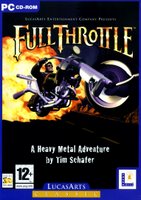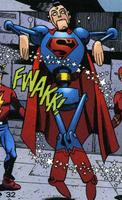Comics Done Right - New Thunderbolts #14
In regards to the New Avengers guest-starring, it was odd that Wolverine wasn’t around. Nicieza probably covered it in the previous issue, but considering that the inclusion of both Spider-Man and Wolverine in this band of heroes is a big part of their appeal, it’s baffling that Wolverine is nowhere to be found in this issue or in any of the other stories featuring the New Avengers in a guest slot this month (She-Hulk, Runaways, Young Avengers...). No skin off my nose, since I dislike seeing Wolverine all over the place to begin with, but it seems at odds with the sentiment of turning the Avengers into a group showcasing their high-profile marketing/merchandise characters (plus Bendis’s favorites, of course).
But since this is not about Bendis’s Avengers, let’s concentrate on the issue at hand, and why it was good. We start off on a good note already with the recap/credits page, which is written in the form of an internal memo from Carol Danvers (the once and former Ms Marvel, presently Warbird) about the so-called “Operation: Hubris”, i.e. the Thunderbolts being engaged to humiliate the New Avengers for intriguing reasons. It’s a great way to bring people up to speed about the plot while also giving us insight in Carol’s own character.
The opening double-page spread of the confrontation between both teams is also a great deal of fun. I’m a big fan of Tom Grummett’s art, as it is a nice example of concentrating on the essentials rather than an overwhelming amount of lines that cover up meaning rather than enhancing it. As stiff and unattractive as Erskine’s pencils are over in the pages of Jack Cross, I think his embellishments here complement well with Grummett’s pencils. Add to that colors that pop off the page and crisp lettering, and you’ve got yourself a nice-looking comic.
It doesn’t hurt at all that the story-page/ad ratio is more than decent. An opening chunk of 6 pages of story, then the usual story/ad/story/ad routine for a few pages, then 3 pages of story, 1 ad, 3 more pages of story, back to story/ad/story/ad and finally another 4 pages of story only broken up by the letters page—speaking of said page, I can’t for the life of me figure out why both Marvel’s letter columns and the DC In Demand pages are so often two pages before the end rather than at the final page. Wouldn’t that make more sense? I assume it’s a printing thing, but since the letter column here corresponds with a page of art in the beginning of the book, same as it would’ve if it were the very last page, I’m left scratching my head here. In any case, unlike some other books Marvel produces, this one has a reasonable flow to it. Things actually happening also helps, naturally :p
Another reason why this was good: I got through the entire issue without having to grimace in annoyance. Quite the opposite, I was often amused by the dialogue or the situations, not to mention intrigued by the subplot about Techno and Abe needing the thrown-out Blizzard to save the world. Now, Zemo and Techno have a history of working together, so I’m assuming they’re in league once more, unless it’ll turn out that they’re actually at odds, because Nicieza does like his twisty-twists, after all. Whatever the case may be, it’s great that the coming months will focus on Zemo and his mad schemes and the way the team will get embroiled in them.
Ever since the start of the first Thunderbolts series, nearly 9 years ago, Baron Helmut Zemo has been a joy to behold as a cunning, ruthless, multi-faceted character who is obviously a villain yet has bizarre heroic tendencies. Kurt Busiek carved out that path for him, to be sure, but Nicieza surely expanded on it. After a year without Zemo, it’s good to have him back—having him revealed as the mastermind behind most of the team’s troubles and misadventures since the relaunch is only icing on the cake.
Highlights of the issue for me were:
- The cover spotlighting a cool-looking Radioactive Man and the beaten Avengers (shown symbolically by a damaged shield, a torn off mask, a battered helmet) with a worn-out Songbird in the back
- Spidey using Atlas as a “building” to attach his webs to (and Atlas subsequently shrinking down)
- Atlas literally stomping on Iron Man
- Spider-Woman and Joystick going through a vicious catfight (over 2 hours!)
- The Avengers realizing that the government is not best pleased with them
- Melissa just leaving Luke Cage hanging for a fight
- Zemo showing up, bringing portents of doom and destruction, always my favorite bit of course :)
To finish up, I want to extoll Grummett’s artistic virtues once more. The man has an excellent eye for laying out a page, always keeping things dynamic without them being confusing. Just look at this page of Joystick and Jessica Drew duking it out, or this one (bonus points for making Spider-Woman look hot but not gross :p). I’m very fond of the way Grummett will tend to shift the panels around, never really making two pages look alike without overdoing it and turning things into a confusing jumble of images. I also get a real sense of things quietening down just from looking at the more organized panels once the fight is over. Writer and artists have a great synergy going on throughout the entire issue, with caption boxes and dialogue adding to the flow of the story rather than clashing with it. Everything just keeps on moving. The final panel zooming in on Zemo makes for a great image to end the issue on (although Spider-Woman’s butt shot only a few pages before that isn’t half bad either :D)
I hope that this Thunderbolts series will be around for a good long time to come because it’s one of my favorite titles on the stands, and it has been since that day in February 1997 when I was stunned—stunned I tell you!—by the out-of-the-blue revelation at the end of the first issue. This book may not be for anyone, as it is not “sophisticated” or anything like that, and admittedly Nicieza has a tendency to get bogged down in McGuffins and plot mechanics rather than telling a straightforward story, but there’s no denying the density of this book; decompression is totally lacking here and that’s just how I like it.
Top things off with a nice letter column and we can come full circle: this one did have it all. I just wish it were biweekly all the time!






























